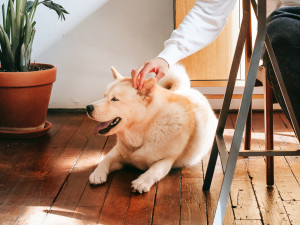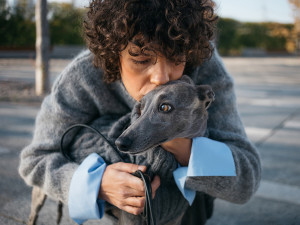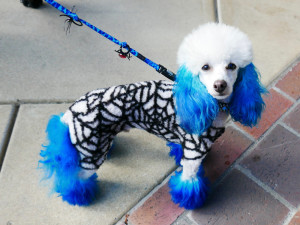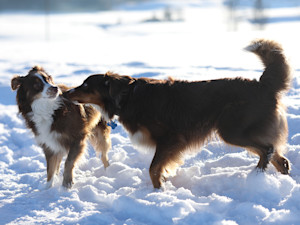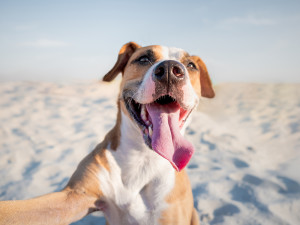FYI, Your Dog Can’t Stand When You Do These 7 Things
Thanks, they hate it.

share article

Your pet wants you to read our newsletter. (Then give them a treat.)
As much as you and your dog are in sync — you know those pouty eyes mean they want your dinner, and they know your stern looks means you won’t share — there are some things about your pup you just don’t get. You could do without the crotch sniffingopens in a new tab, for example. And they probably think you’re a weirdo, too.
Instead of sniffing each other, humans squeeze each other “hello” in a way that dogs just don’t understand — or necessarily like. It’s not too far-fetched to say that they’d pass on many things people enjoy if given a choice.
Here are a few items on most dogs’ list of things they wish people wouldn’t do.
Your dog is probably thinking, Thanks, I hate it, if you…
1. Pat them on the head
Head pats are meant to convey affection, and many pet parents love to do it. But patting your dog on the headopens in a new tab is not popular with them. Most dogs dislike it and will move away to avoid it. They do usually enjoy having their heads — including their ears and the sides of their faces — smoothly stroked, which is more likely to make them happy, keep them near and cause them to lean in for more.
2. Hug them
Every time a dog trainer or canine behaviorist mentions that dogs don’t necessarily like being hugged, the pushback is incredible. Everyone is sure their dog loves to be hugged, even if most dogs don’t. Primates (the order to which humans belong) are huggers, but canids, including dogs, don’t naturally engage in that behavior. Dogs who are being hugged often display signs of stressopens in a new tab, including tongue flicks, a tightly closed mouth, pulled-back earsopens in a new tab, rigid facial muscles and/or a furrowed brow. Putting your arms around your dog’s neck and shoulders may feel like love to you, but to dogs, not so much.
3. Hoard the ball during a game of fetch
You’ve probably picked up the ball and held it while praising your dog. You think you’re playing fetch, but your dog thinks you’re hoarding the ball. They want it back, and they want it back now. Many dogs lose interest in fetch — or fail to learn how fun it can beopens in a new tab —because of this human tendency to hold onto the ball instead of immediately throwing it. What they want us to do is toss the ball the instant they drop it anywhere in our vicinity. This sounds simple, but it can be a struggle for many pet parents.
4. Kiss them
Humans express love and affection with kisses, but kisses have no particular meaning to dogs. It is not a natural part of their repertoire. Dogs lick each other and will lick humans, tooopens in a new tab, and though we often call those “doggy kisses,” they’re different than human kisses. Putting your face right next to a dog’s face can be perceived by the dog as threatening behavior. Some dogs find it scary, while others simply find it annoying. It’s common for dogs who are being kissed to try to get away, to hold their ears back, or to exhibit signs of discomfort such as tongue-flicking, yawning, lowering the tail or displaying facial and body tension. Some dogs wrinkle their noses or even scamper off once released — another sign that they don’t love being kissed no matter how much they love you.
5. Hold one of their paws — especially a back paw — when they’re standing
Dogs who’ve been consistently reinforced for shaking or giving a high-five may have good feelings about having you touch or hold their paws, but that usually only applies to brief contact while they’re sitting. Nothing good can come of grabbing a dog’s paw and holding on to it for a while. It may make them feel unstable, and that’s no fun, or they may associate it with nail trims (also no fun) or having their muddy paws wiped down (not awful, but not a favorite either). Holding a dog’s back paw is often particularly poorly received.
6. Use citrus-scented products
The majority of dogs hate the smell of citrus: lemons, tangerines, and grapefruit. That’s why those scents are used in products meant to deter dogs from chewing on things we would prefer they leave alone. Because the smell repels dogs, it’s kind to avoid products with that scent, including lotion, shampoo, air fresheners, or candles. A small percentage of dogs aren’t averse to these smells. Find out if your dog is in this group by peeling a juicy orange, so your hands are covered in a sticky mess, then offer your hands to your dog. If they turn or back away, they (like most dogs) don’t care for the smell of citrus. If they lick your fingers, different story.
7. Dress them.
The joy pet parents take in dressing up their dogs is often in direct conflict with the distaste dogs have for the experience. Yes, dogs look adorable in just about every outfit under the sun, but very few dogs enjoy the process of being put into clothes and costumes. Lots of dogs tense up, displaying facial expressions and body language that clearly indicate their discomfort. Wearing clothes, especially cumbersome and constricting costumes, is a misery for many dogs.
Through careful conditioning, dogs can be taught to accept costumes or other clothes. If you must, choose the least restrictive and most lightweight options, but dogs would really prefer you miss them with the costume. Many pet parents can’t help but love the look of dogs dressed to the nines, but mostly, it’s better not to treat dogs like dolls.
Apologies to your Halloween plans.

Karen B. London, PhD, CAAB, CPDT-KA
Karen B. London, Ph.D., is a Certified Applied Animal Behaviorist and Certified Professional Dog Trainer who specializes in working with dogs with serious behavioral issues, including aggression, and has also trained other animals including cats, birds, snakes, and insects. She writes the animal column for the Arizona Daily Sun and is an Adjunct Professor in the Department of Biological Sciences at Northern Arizona University. She is the author of six books about training and behavior, including her most recent, Treat Everyone Like a Dog: How a Dog Trainer’s World View Can Improve Your Lifeopens in a new tab.
Related articles
![Unrecognizable man sitting at desk petting his dog]() opens in a new tab
opens in a new tabHow to Pet a Dog — Yes, You Do Need Lessons
There’s a difference between being affectionate and being annoying.
![Two Australian Shepherd dogs meeting in the snow]() opens in a new tab
opens in a new tabAre Your Dogs Arguing With Each Other?
How to tell the difference between dog aggression and communication.
![Russian Toy Terrier with ears back]() opens in a new tab
opens in a new tab9 Reasons Why Dogs Put Their Ears Back
Here’s how your dog’s ears can clue you in to how they’re feeling.
![Dog in the sand smiling at the camera]() opens in a new tab
opens in a new tabCan Dogs Smile?
There’s a big difference between a dog smiling and showing their teeth.
